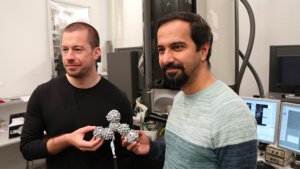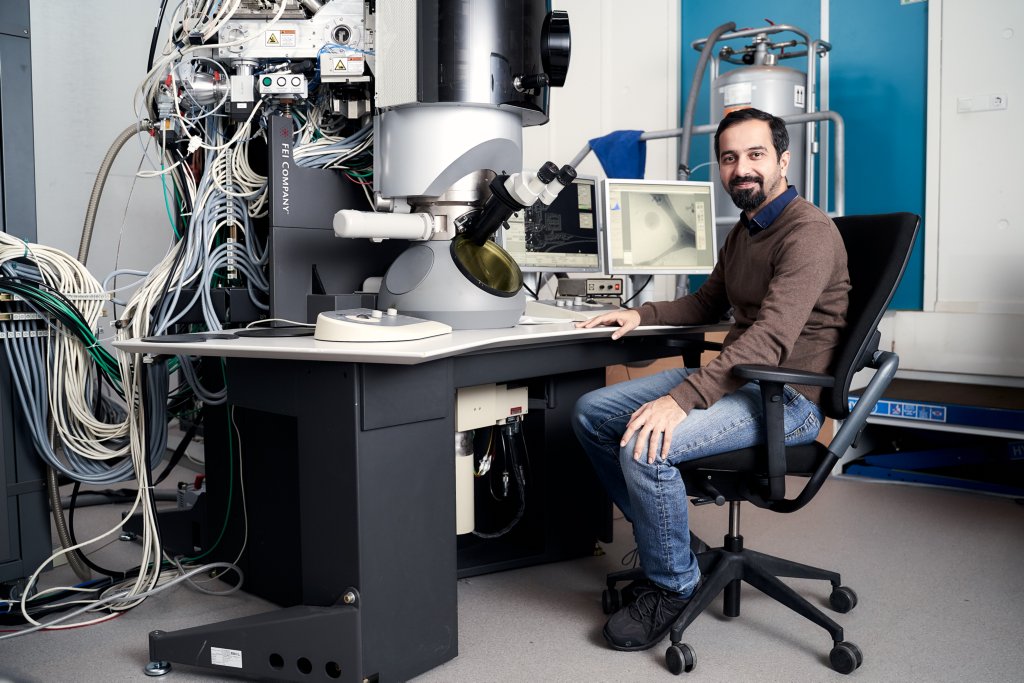Understanding structure formation in hierarchical hybrid materials through in situ liquid phase microscopies (TU/e)
- Project leader was: prof.dr. Nico Sommerdijk (now Professor in the Department of Biochemistry at the Radboud Institute for Molecular Life Sciences)
- Postdoc: dr. Mohammad Moradi (TU/e, Department of Chemical Engineering and Chemistry, Materials and Interface Chemistry ) - who succeeded dr. Joe Patterson (now at Department of Chemistry, University of California, Irvine)
- International expert: prof.dr. James J. De Yoreo (Department of Chemistry, University of Washington)
Scientific paper Nature Materials (2021)
Moradi, M.A., Eren, E.D., Chiappini, M. et al. Spontaneous organization of supracolloids into three-dimensional structured materials. Nat. Mater. (2021).
https://doi.org/10.1038/s41563-020-00900-5
Interview
'Shedding electrons on the formation of hybrid designer materials'
Stretching the boundaries of materials. Six projects of the 4TU.HTM programme 'New Horizons in Designer Materials', p.20-29, March 2020.
 Within the project first Joe Patterson (now at University of California, Irvine) and later Mohammad Moradi (Eindhoven University of Technology) as his successor aimed to create hybrid materials and analyse their formation processes synchronously with the use of advanced microscopy techniques, in particular liquid-phase electron microscopy (LP-EM). The project has provided fundamental insights that can be used to control the thermodynamics and kinetics of dynamic processes of molecules with both hydrophilic and hydrophobic properties (amphiphilic molecules). The potential impact is huge, think of medicine, energy, catalysis, and this breakthrough also has important implications for understanding materials in living systems.
Within the project first Joe Patterson (now at University of California, Irvine) and later Mohammad Moradi (Eindhoven University of Technology) as his successor aimed to create hybrid materials and analyse their formation processes synchronously with the use of advanced microscopy techniques, in particular liquid-phase electron microscopy (LP-EM). The project has provided fundamental insights that can be used to control the thermodynamics and kinetics of dynamic processes of molecules with both hydrophilic and hydrophobic properties (amphiphilic molecules). The potential impact is huge, think of medicine, energy, catalysis, and this breakthrough also has important implications for understanding materials in living systems.
Abstract
The functionality of many materials depends on their hierarchical organization. Although in biology such materials are formed through the self-organization of preformed building blocks, the bottom-up assembly of synthetic materials with predefined structures and properties is still out of reach. Our long term vision is to enable synthesis of hierarchical hybrid materials through multiscale assembly by combining the macromolecular self-assembly of predefined building blocks with their subsequent organization into mesostructured materials. To achieve this vision, we must first develop the capability to monitor structure formation in situ and on all relevant length and time scales, from the nanometer to the (multi)micron level. We will use LP-TEM to study molecular-scale self-assembly, LP-STEM to probe self-organization at the mesoscale, and LP-AFM to quantify particle interaction energies and map the near-surface liquid structure to obtain a comprehensive understanding of the evolution of structure and morphology in multiscale assembly.
We will demonstrate our approach using a model materials platform: polymer nanoparticles with bicontinuous internal structure will be assembled from block copolymers and infiltrated with SiO2, forming hybrid building blocks with defined size and internal structure. These mineralized nano particles will then be organized into mesoscopically ordered, hierarchical materials.
Biography Postdoc
Mohammad-Amin Moradi received his BSc degree in Chemical Engineering from University of Tehran and his Master of Science in Polymer Nanomaterials at Sahand University of Technology on Polymer-Diamondoid Nanocomposites. In his PhD time at Eindhoven University of Technology, he investigated Carbon nanotube-latex conductive coatings and encapsulation of vesicle templates at the Laboratory of Polymer Chemistry. In June 2016, Mohammad started a postdoctoral project at Laboratory of Materials and Interface Chemistry, TU Eindhoven under supervision of Prof. Nico Sommerdijk. He joined the 4TU project from April 2017 and is currently investigating a multiscale self-assembly route to achieve ordered hybrid materials.
Mohammad-Amin won the poster prize in polymer physics at Dutch Polymer Days annual conference of 2015 for “Bimodal latex effect on spin coated SWCNT-latex conductive nano layers”. He was also awarded the poster prize of Royal Microscopical Society- Microscopy characterization of organic-inorganic interfaces conference of 2017 at Queen Marry University of London for “Exploring the self-assembly of hybrid materials using cryo-electron microscopy”.

Photo: Ernst de Groot
Papers
In collaboration with prof. Nico A.J.M. Sommerdijk and Mark M.J. van Rijt M.Sc.(TU/e), dr. Mohammad-Amin Moradi wrote a paper in the digital magazine Innovative Materials:
'Understanding Structure Formation in Hierarchical Hybrid Materials using Cryogenic Electron Tomography and Liquid Phase Electron Microscopy' by Mohammad-Amin Moradi and Nico A.J.M. Sommerdijk (TU/e).
Innovative Materials, 2018, 6, pp. 38-40 (Pdf file)
Also available in Dutch:
'Structuurvorming in hiërarchische hybride materialen met behulp van cryo-elektronentomografie en vloeistofelektronenmicroscopie' door Mohammad-Amin Moradi, Mark M.J. van Rijt en Nico A.J.M. Sommerijk (TU/e).
Innovatieve Materialen, 2018, 6, pp. 42-45 (Pdf file)



